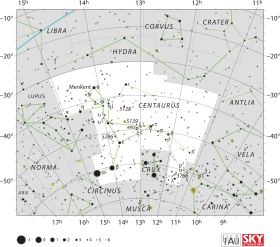HD 114837
| Ascension droite | 13h 14m 15,14474s[1] |
|---|---|
| Déclinaison | −59° 06′ 11,6540″[1] |
| Constellation | Centaure |
| Magnitude apparente | 4,92[2] |
Localisation dans la constellation : Centaure | |
| Type spectral | F6 V Fe-0,4[3] |
|---|---|
| Indice B-V | +0,48[2] |
| Indice R-I | +0,27[2] |
| Vitesse radiale | −63,57 ± 0,12 km/s[1] |
|---|---|
| Mouvement propre |
μα = −248,678 mas/a[1] μδ = −153,176 mas/a[1] |
| Parallaxe | 54,824 7 ± 0,080 9 mas[1] |
| Distance | 18,240 ± 0,027 pc (∼59,5 al)[4] |
| Magnitude absolue | +3,73[5] |
| Masse | 1,14 M☉[6] |
|---|---|
| Rayon | 1,51 R☉[1] |
| Gravité de surface (log g) | 4,21[7] |
| Luminosité | 3,07 L☉[1] |
| Température | 6 346 ± 80 K[7] |
| Métallicité | [Fe/H] = −0,27[7] |
| Rotation | 8,8 ± 3,0 km/s[5] |
| Âge | 3,40 × 109 a[7] |
Désignations
HD 114837, également désignée HR 4989, est une étoile binaire[6],[8] de la constellation australe du Centaure. Elle est visible à l'œil nu avec une magnitude apparente de 4,92[2].
L'étoile primaire, désignée HD 114837 A, présente une parallaxe annuelle de 54,82 ± 0,08 mas telle que mesurée par le satellite Gaia, ce qui permet d'en déduire qu'elle est distante de 18,24 ± 0,03 pc (∼59,5 al) de la Terre[1]. Elle se rapproche actuellement du Système solaire à une vitesse radiale de −63,6 km/s[1], et passera au plus près dans environ 240 600 ans, où elle ne sera plus distante que d'environ 6,68 pc (∼21,8 al)[9].
HD 114837 A est une étoile jaune-blanc de la séquence principale de type spectral F6 V Fe-0,4[3], avec la notation « Fe-0,4 » qui indique que son spectre montre une sous-abondance en fer ; cette dernière ne vaut en effet que 53 % l'abondance solaire[7]. L'étoile est âgée d'environ 3,4 milliards d'années[7], elle est 1,14 fois plus massive que le Soleil[6] et son rayon est 1,51 fois plus grand que le rayon solaire[1]. Elle est 3,07 fois plus lumineuse que le Soleil[1] et sa température de surface est de 6 346 K[7]
Son compagnon, HD 114837 B, est une étoile de magnitude 10,2 avec qui elle partage un mouvement propre commun[8] et qui est située à la même distance d'environ 18,2 pc (∼59,4 al)[10]. En date de 2016, elle était localisée à une distance angulaire de 4,6 secondes d'arc et selon un angle de position de 22° de HD 114837 A[11]. Cette étoile ne fait que 56 % la masse du Soleil et 55 % son rayon. Sa luminosité vaut à peine 6 % celle du Soleil et sa température de surface est de 3 817 K[10].
Notes et références
[modifier | modifier le code]- (en) Cet article est partiellement ou en totalité issu de l’article de Wikipédia en anglais intitulé « HD 114837 » (voir la liste des auteurs).
- (en) A. Vallenari et al. (Gaia collaboration), « Gaia Data Release 3 : Summary of the content and survey properties », Astronomy & Astrophysics, vol. 674, , article no A1 (DOI 10.1051/0004-6361/202243940, Bibcode 2023A&A...674A...1G, arXiv 2208.00211). Notice Gaia DR3 pour cette source sur VizieR.
- (en) D. Hoffleit et W. H. Warren, « Bright Star Catalogue, 5e éd. », Catalogue de données en ligne VizieR : V/50. Publié à l'origine dans : 1964BS....C......0H, vol. 5050, (Bibcode 1995yCat.5050....0H)
- (en) R. O. Gray et al., « Contributions to the Nearby Stars (NStars) Project: spectroscopy of stars earlier than M0 within 40 pc-The Southern Sample », The Astronomical Journal, vol. 132, no 1, , p. 161–170 (DOI 10.1086/504637, Bibcode 2006AJ....132..161G, arXiv astro-ph/0603770)
- (en) HD 114837 -- High Proper Motion Star sur la base de données Simbad du Centre de données astronomiques de Strasbourg.
- (en) Matthias Ammler-von Eiff et Ansgar Reiners, « New measurements of rotation and differential rotation in A-F stars: are there two populations of differentially rotating stars? », Astronomy & Astrophysics, vol. 542, , A116 (DOI 10.1051/0004-6361/201118724, Bibcode 2012A&A...542A.116A, arXiv 1204.2459, S2CID 53666672)
- (en) K. Fuhrmann et al., « Multiplicity among Solar-type Stars », The Astrophysical Journal, vol. 836, , p. 139 (DOI 10.3847/1538-4357/836/1/139, Bibcode 2017ApJ...836..139F)
- (en) L. Casagrande et al., « New constraints on the chemical evolution of the solar neighbourhood and Galactic disc(s). Improved astrophysical parameters for the Geneva-Copenhagen Survey », Astronomy & Astrophysics, vol. 530, , A138 (DOI 10.1051/0004-6361/201016276, Bibcode 2011A&A...530A.138C, arXiv 1103.4651, S2CID 56118016)
- (en) R. Chini et al., « New visual companions of solar-type stars within 25 pc », Monthly Notices of the Royal Astronomical Society, vol. 437, no 1, , p. 879–886 (DOI 10.1093/mnras/stt1953, Bibcode 2014MNRAS.437..879C, arXiv 1310.2684)
- (en) C. A. L. Bailer-Jones, « Close encounters of the stellar kind », Astronomy & Astrophysics, vol. 575, , p. 13, article no A35 (DOI 10.1051/0004-6361/201425221, Bibcode 2015A&A...575A..35B, arXiv 1412.3648, S2CID 59039482)
- (en) A. Vallenari et al. (Gaia collaboration), « Gaia Data Release 3 : Summary of the content and survey properties », Astronomy & Astrophysics, vol. 674, , article no A1 (DOI 10.1051/0004-6361/202243940, Bibcode 2023A&A...674A...1G, arXiv 2208.00211). Notice Gaia DR3 pour cette source sur VizieR.
- (en) Brian D. Mason et al., « The 2001 US Naval Observatory Double Star CD-ROM. I. The Washington Double Star Catalog », The Astronomical Journal, vol. 122, no 6, , p. 3466 (DOI 10.1086/323920, Bibcode 2001AJ....122.3466M)
Liens externes
[modifier | modifier le code]- (en) HD 114837 A sur la base de données Simbad du Centre de données astronomiques de Strasbourg.
- (en) HD 114837 B sur la base de données Simbad du Centre de données astronomiques de Strasbourg.
Text is available under the CC BY-SA 4.0 license; additional terms may apply.
Images, videos and audio are available under their respective licenses.

